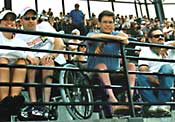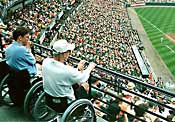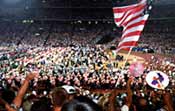Faces of the ADA
Lee Page -- "Thanks to the ADA,
there’s a new standard of access for stadiums."
Sitting in a stadium watching a ball game, yelling for your team, eating a hot dog. One of America’s great pasttimes. Lee Page, a wheelchair user from Virginia, goes to ball games to see the action in person and to be a part of the crowd, like everyone else. But for years, accessible seating was usually located far away from the action with a bad view, or was so isolated from companions and other spectators that interaction was difficult at best.
Page recalled experiences in stadiums built before the ADA where "All the accessible seating was located in the end zone part of the stadium. Wheelchair users sat up on a cement slab with a railing in front. Your companion, the person you came to the event with, would sit in a fixed seat in front of you and the railing, but at a much lower level. I didn’t really feel part of the crowd and it was difficult to interact with my friend."
Following investigations of complaints filed by people with disabilities from the Atlanta metropolitan area, the Department of Justice entered into agreements to ensure full accessibility of five newly constructed venues for the Olympic and Paralympic Games, including the Olympic Stadium, the site of track and field competitions and the opening and closing ceremonies. Under the agreements, the facilities designated at least one percent of the total seats for wheelchair users dispersed throughout the facility; provided a companion seat adjacent to each wheelchair space to allow spectators with disabilities to sit next to family and friends; and ensured that accessible seats provide lines of sight comparable to other spectators, so that wheelchair users can still see the playing surface even when spectators in front of them stand up during the event. Accessible routes from parking and transportation areas to accessible seating that connect to all public areas of the facilities were provided, as well a full access to all concession stands, restrooms, automatic bank machines, and other amenities.
July 24, 2000



